Enhancement and Reduction of Nonradiative Decay Process in Organic Light-Emitting Diodes by Gold Nanoparticles
Abstract
:1. Introduction
2. Experimental Section
3. Results and Discussion
4. Conclusions
Acknowledgments
Author Contributions
Conflicts of Interest
References
- Lee, S.J.; Seo, J.H.; Kim, J.H.; Kim, H.M.; Lee, K.H.; Yoon, S.S.; Kim, Y.K. Efficient triplet exciton confinement of white organic light-emitting diodes using a heavily doped phosphorescent blue emitter. Thin Solid Film 2010, 518, 6184–6187. [Google Scholar] [CrossRef]
- Zhang, Y.; Slootsky, M.; Forrest, S.R. Enhanced efficiency in high-brightness fluorescent organic light emitting diodes through triplet management. Appl. Phys. Lett. 2011, 99, 223303. [Google Scholar] [CrossRef]
- Xie, C.Y.G.; Murawski, C.; Lee, J.; Ventsch, F.; Leo, K.; Gather, M.C. Understanding the influence of doping in efficient phosphorescent organic light-emitting diodes with an organic p–i–n homojunction. Org. Electron. 2013, 14, 1695–1703. [Google Scholar]
- Xhao, Y.; Duan, L.; Zhang, D.; Hou, L.; Qiao, J.; Wang, L.; Qiu, Y. Small molecular phosphorescent organic light-emitting diodes using a spin-coated hole blocking layer. Appl. Phys. Lett. 2012, 100, 083304. [Google Scholar]
- Narayan, K.; Varadarajaperumal, S.; Rao, G.M.; Varma, M.M.; Srinivas, T. Effect of thickness variation of hole injection and hole blocking layers on the performance of fluorescent green organic light emitting diodes. Curr. Appl. Phys. 2013, 13, 18–25. [Google Scholar] [CrossRef]
- Park, Y.W.; Choi, J.H.; Park, T.H.; Song, E.H.; Kim, H.; Lee, H.J.; Shin, S.J.; Ju, B.-K.; Song, W.J. Barrierless hole injection through sub-bandgap occupied states in organic light emitting diodes using substoichiometric MoOx anode interfacial layer. Appl. Phys. Lett. 2012, 100, 013312. [Google Scholar]
- Kim, K.; Hong, K.; Lee, I.; Kim, S.; Lee, J.-L. Electron injection in magnesium-doped organic light-emitting diodes. Appl. Phys. Lett. 2012, 101, 141102. [Google Scholar] [CrossRef]
- Sun, Y.; Foorrest, S.R. Enhanced light out-coupling of organic light-emitting devices using embedded low-index grids. Nat. Photon. 2008, 2, 483–487. [Google Scholar] [CrossRef]
- Koh, T.W.; Choi, J.M.; Lee, S.; Yoo, S. Optical Outcoupling Enhancement in Organic Light-Emitting Diodes: Highly Conductive Polymer as a Low-Index Layer on Microstructured ITO Electrodes. Adv. Mater. 2010, 22, 1849–1853. [Google Scholar] [CrossRef] [PubMed]
- WBarnes, L.; Dereux, A.; Ebbesen, T.W. Surface plasmon subwavelength optics. Nature 2003, 424, 824–830. [Google Scholar] [CrossRef] [PubMed]
- Kumar, A.; Tyagi1, P.; Srivastava1, R.; Mehta, D.S.; Kamalasanan, M.N. Energy transfer process between exciton and surface plasmon: Complete transition from Forster to surface energy transfer. Appl. Phys. Lett. 2013, 102, 203304. [Google Scholar] [CrossRef]
- Kumar, A.; Srivastava, R.; Tyagi, P.; Mehta, D.S.; Kamalasanan, M.N. Efficiency enhancement of organic light emitting diode via surface energy transfer between exciton and surface plasmon. Org. Electron. 2012, 13, 159–165. [Google Scholar] [CrossRef]
- Kim, T.; Kang, H.; Jeong, S.; Kang, D.J.; Lee, C.; Lee, C.H.; Seo, M.K.; Lee, J.Y.; Kim, B.J. Au@ Polymer Core–Shell Nanoparticles for Simultaneously Enhancing Efficiency and Ambient Stability of Organic Optoelectronic Devices. ACS Appl. Mater. Interfaces 2014, 6, 16956–16965. [Google Scholar] [CrossRef] [PubMed]
- Kumar, A.; Srivastava, R.; Mehta, D.S.; Kamalasanan, M.N. Surface plasmon enhanced blue organic light emitting diode with nearly 100% fluorescence efficiency. Org. Electron. 2012, 13, 1750–1755. [Google Scholar] [CrossRef]
- Choi, H.; Ko, S.J.; Choi, Y.; Joo, P.; Kim, T.; Lee, B.R.; Jung, J.W.; Choi, H.J.; Cha, M.; Jeong, J.R.; et al. Status and prospects for ternary organic photovoltaics. Nat. Photonics 2015, 9, 491–500. [Google Scholar]
- Kim, D.H.; Kim, T.W. Enhancement of the current efficiency of organic light-emitting devices due to the surface plasmonic resonance effect of dodecanethilol-functionalized Au nanoparticles. Org. Electron. 2016, 34, 262–266. [Google Scholar] [CrossRef]
- Chen, Y.C.; Gao, C.Y.; Chen, K.L.; Meen, T.H.; Huang, C.J. Enhancement and Quenching of Fluorescence by Silver Nanoparticles in Organic Light-Emitting Diodes. J. Nanomater. 2013, 2013, 841436. [Google Scholar] [CrossRef]
- Xiao, Y.; Yang, J.P.; Cheng, P.P.; Zhu, J.J.; Xu, Z.Q.; Deng, Y.H.; Lee, S.T.; Li, Y.Q.; Tang, J.X. Surface plasmon-enhanced electroluminescence in organic light-emitting diodes incorporating Au nanoparticles. Appl. Phys. Lett. 2012, 100, 013308. [Google Scholar] [CrossRef]
- Huang, C.J.; Chiu, P.H.; Wang, Y.H.; Chen, K.L.; Linn, J.J.; Yang, C.F. Electrochemically Controlling the Size of Gold Nanoparticles Electrochemical Synthesis and Engineering. J. Electrochem. Soc. 2006, 153, D193–D198. [Google Scholar] [CrossRef]
- Huang, C.J.; Chiu, P.H.; Wang, Y.H.; Chen, W.R.; Meen, T.H. Synthesis of the Gold Nanocubes by Electrochemical Technique Electrochemical Synthesis and Engineering. J. Electrochem. Soc. 2006, 153, D129–D133. [Google Scholar] [CrossRef]
- Chen, Y.C.; Gao, C.Y.; Chen, K.L.; Huang, C.J. Surface plasmon-enhanced localized electric field in organic light-emitting diodes by incorporating silver nanoclusters. Appl. Surf. Sci. 2014, 295, 266–269. [Google Scholar] [CrossRef]
- Gao, C.Y.; Chen, Y.C.; Chen, K.L.; Huang, C.J. Surface plasmon enhanced organic light emitting diodes by gold nanoparticles with different sizes. Appl. Surf. Sci. 2015, 356, 791–794. [Google Scholar] [CrossRef]
- Yun, C.S.; Javier, A.; Jennings, T.; Fisher, M.; Hira, S.; Peterson, S.; Hopkins, B.; Reich, N.O.; Strouse, G.F. Nanometal Surface Energy Transfer in Optical Rulers, Breaking the FRET Barrier. J. Am. Chem. Soc. 2005, 127, 3115–3119. [Google Scholar] [CrossRef] [PubMed]
- Zhang, X.; Marocico, C.A.; Lunz, M.; Gerard, V.A.; Gun’ko, Y.K.; Lesnyak, V.; Gaponik, N.; Susha, A.S.; Rogach, A.L.; Bradley, A.L. Wavelength, Concentration, and Distance Dependence of Nonradiative Energy Transfer to a Plane of Gold Nanoparticles. ACS Nano 2012, 6, 9283–9290. [Google Scholar] [CrossRef] [PubMed]
- Lakowicz, J.R. Principles of Fluorescence Spectroscopy; Kluwer Academic/Plenum: New York, NY, USA, 1999. [Google Scholar]
- Van der Meer, B.W.; Coker, G.; Chen, S.Y.S. Resonance Energy Transfer: Theory and Data; VCH: New York, NY, USA, 1994. [Google Scholar]
- Gao, C.Y.; Chen, Y.C.; Chen, K.L.; Huang, C.J. Double surface plasmon enhanced organic light-emitting diodesby gold nanoparticles and silver nanoclusters. Appl. Surf. Sci. 2015, 359, 749–753. [Google Scholar] [CrossRef]
- Feng, S.W. Dependence of the dynamics of exciton transport, energy relaxation, and localization on dopant concentration in disordered C545Tdoped Alq3 organic semiconductors. Opt. Mater. Express 2014, 4, 798–809. [Google Scholar] [CrossRef]
- So, F.; Kondakoc, D. Degradation Mechanisms in Small-Molecule and Polymer Organic Light-Emitting Diodes. Adv. Mater. 2010, 22, 3762–3777. [Google Scholar] [CrossRef] [PubMed]
- Ford, G.W.; Weber, W.H. Electromagnetic interactions of molecules with metal surfaces. Phys. Rep.-Rev. Sec. Phys. Lett. 1984, 113, 195–287. [Google Scholar] [CrossRef]

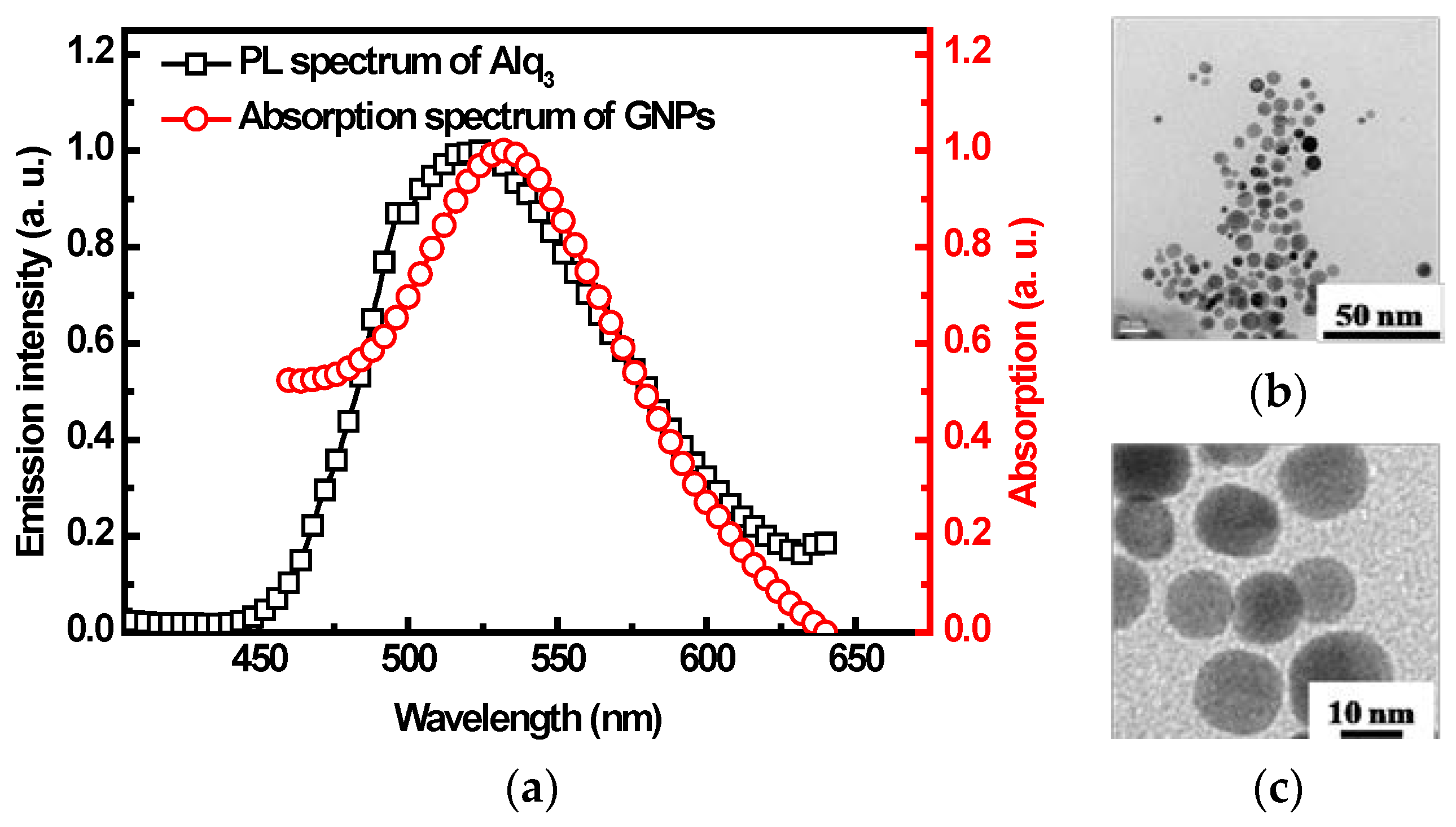
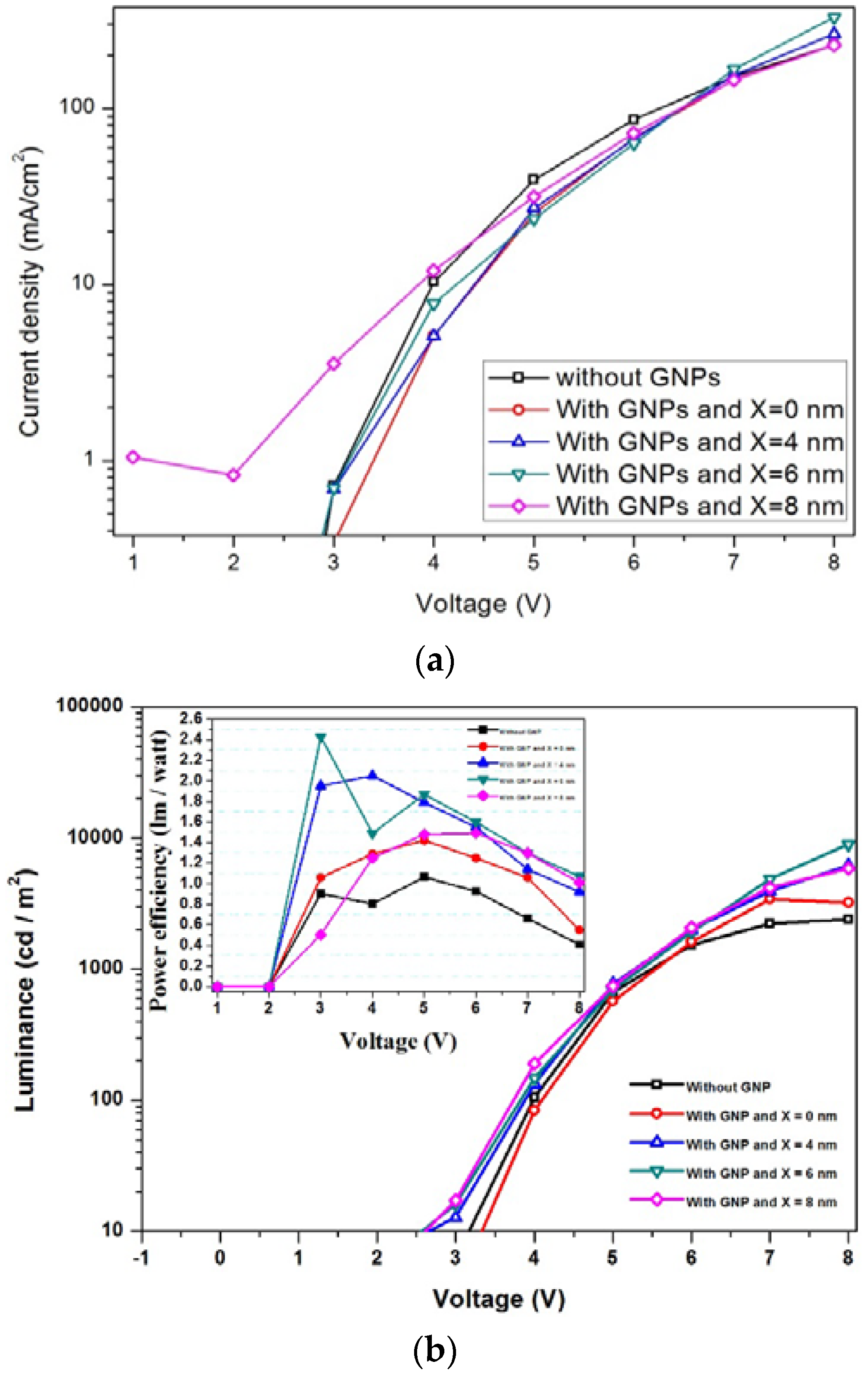
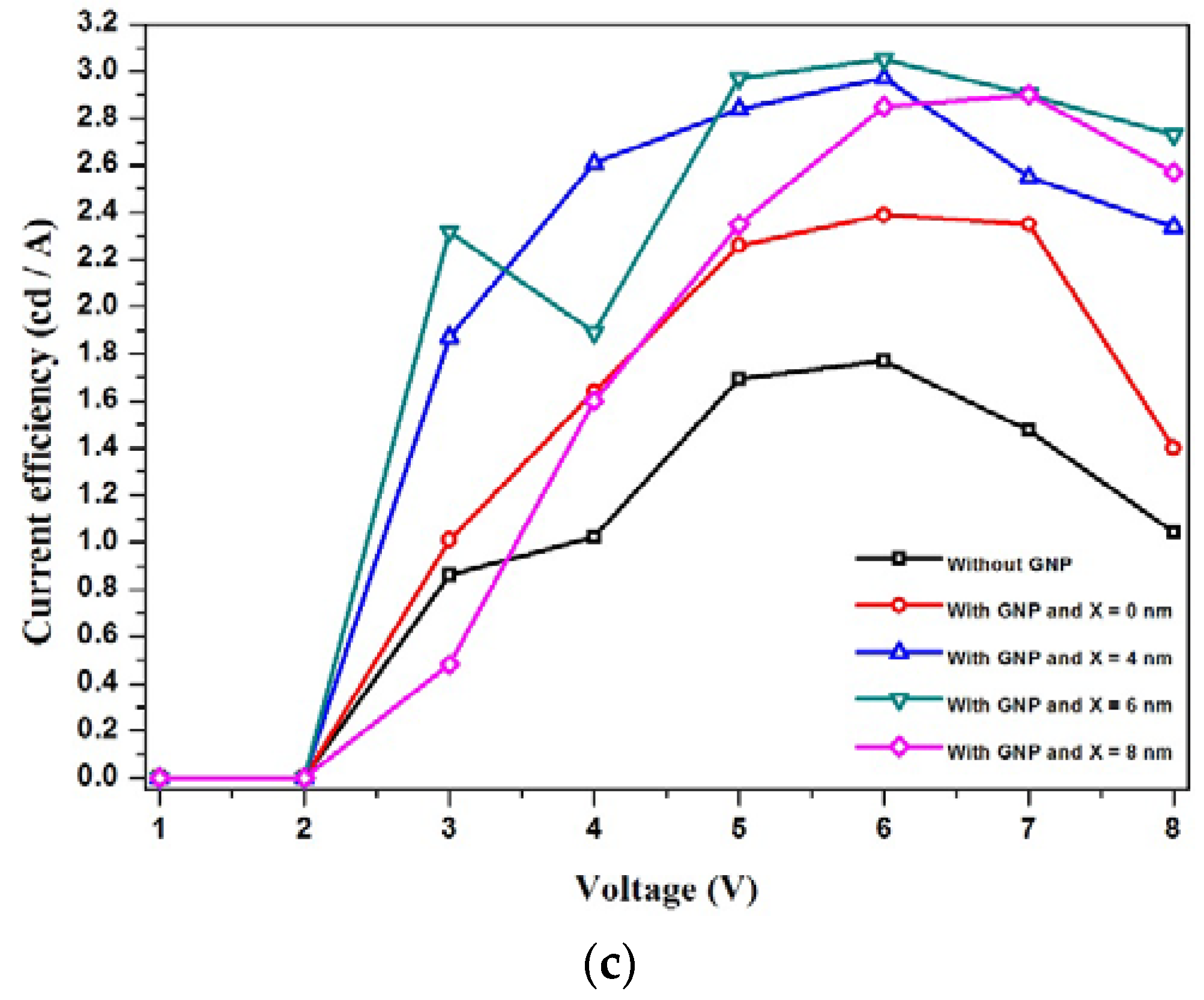
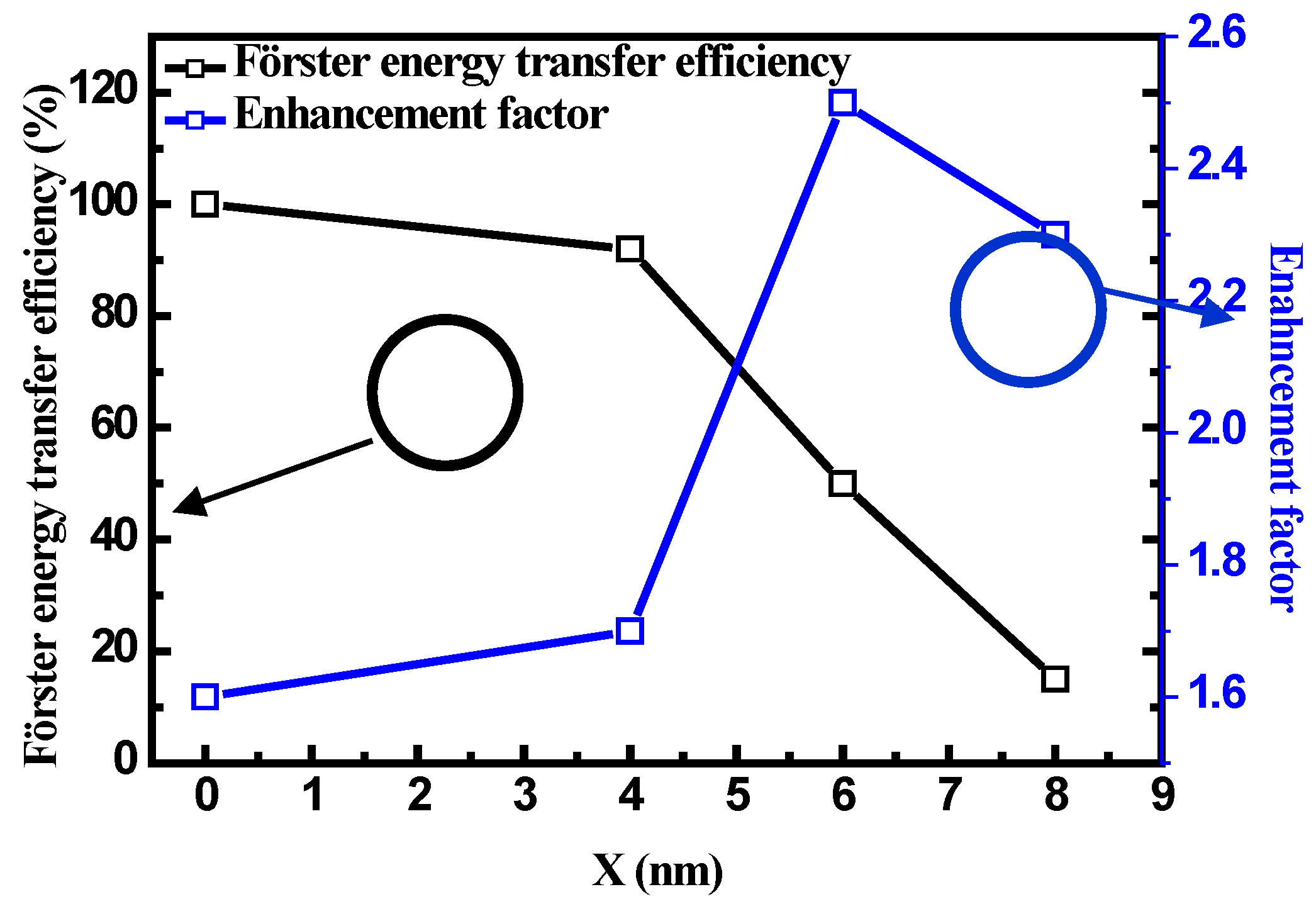
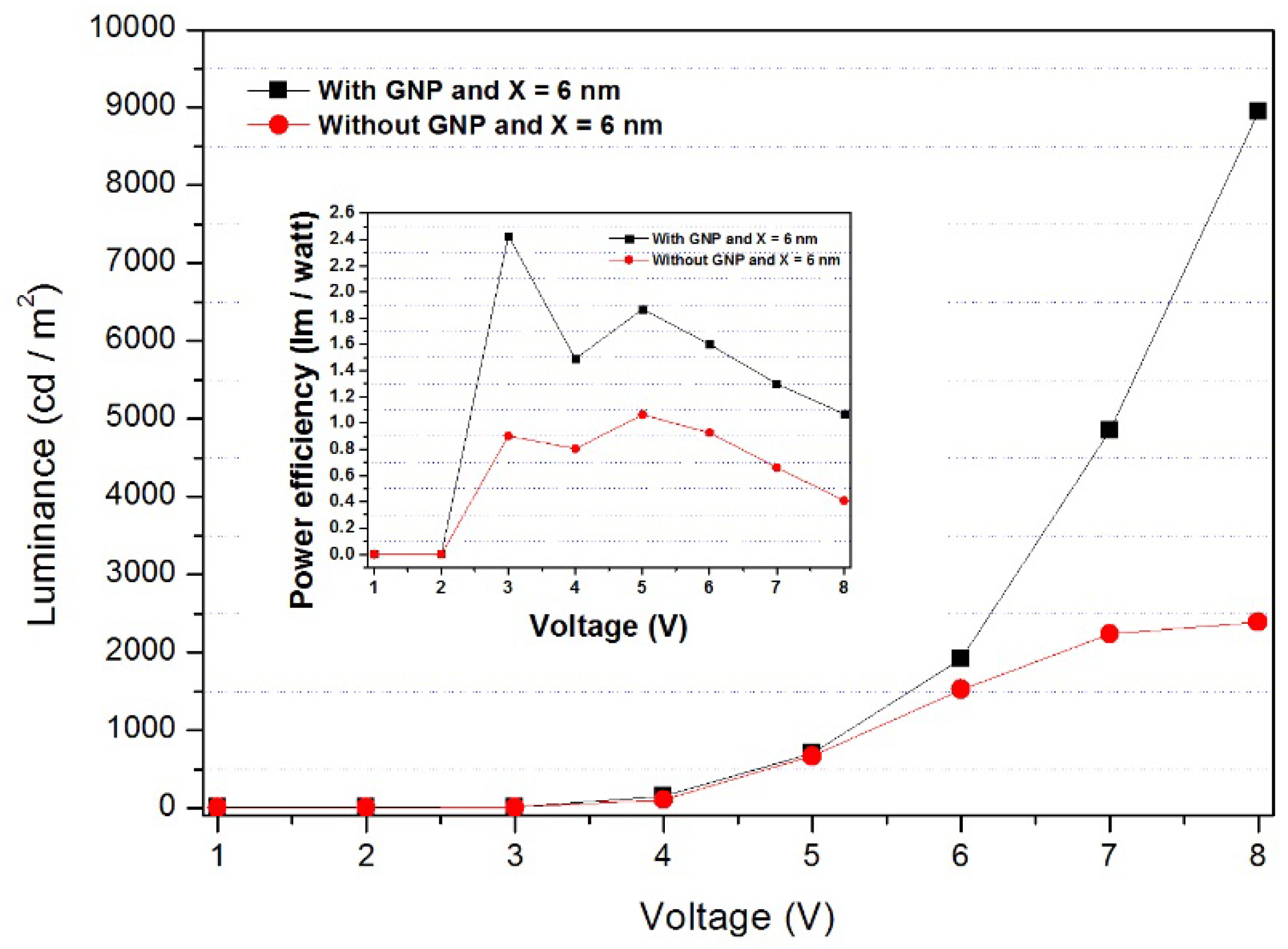
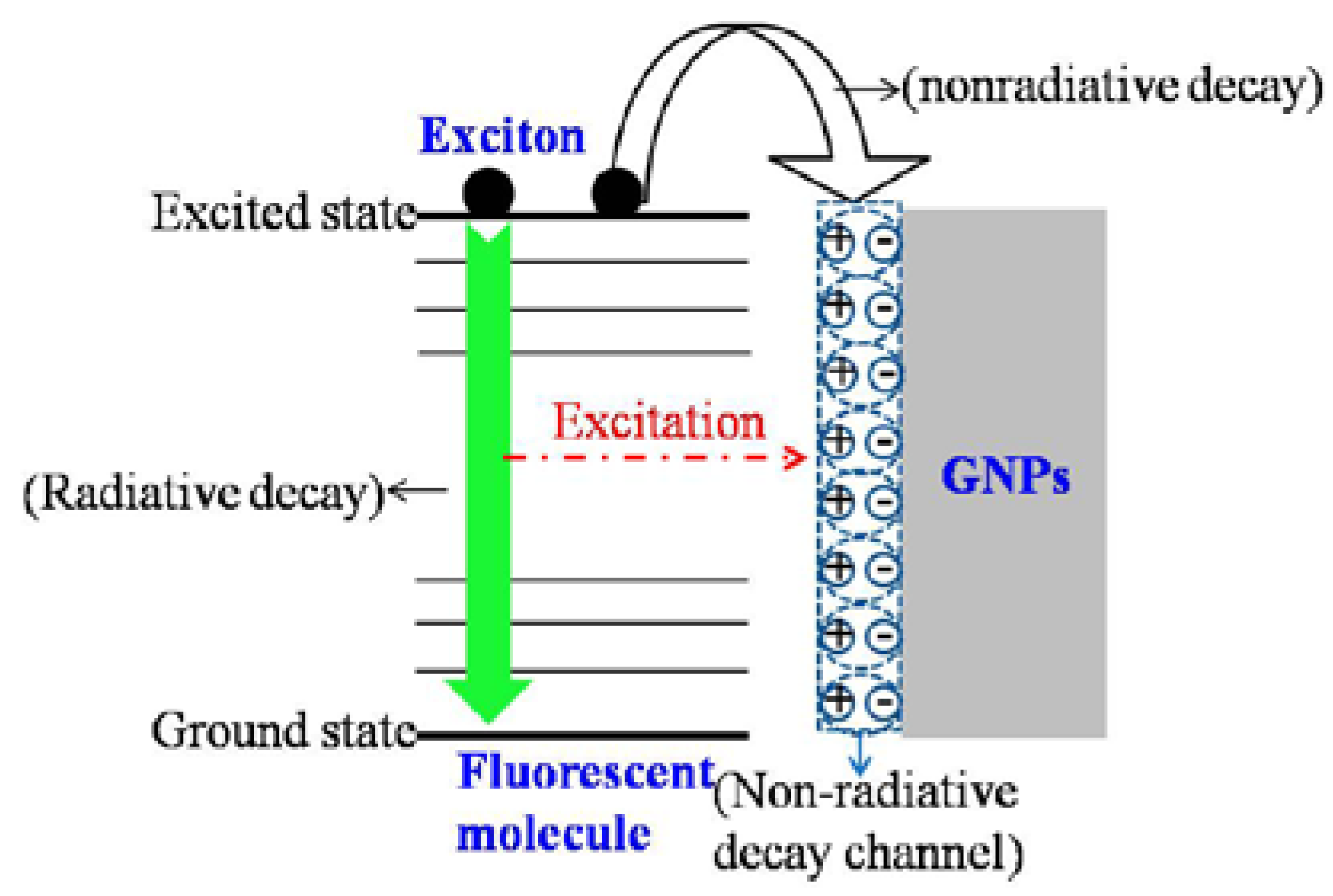
© 2016 by the authors; licensee MDPI, Basel, Switzerland. This article is an open access article distributed under the terms and conditions of the Creative Commons Attribution (CC-BY) license (http://creativecommons.org/licenses/by/4.0/).
Share and Cite
Gao, C.-Y.; Chen, K.-L.; Sze, P.-W.; Chen, Y.-C.; Huang, C.-J. Enhancement and Reduction of Nonradiative Decay Process in Organic Light-Emitting Diodes by Gold Nanoparticles. Appl. Sci. 2016, 6, 441. https://doi.org/10.3390/app6120441
Gao C-Y, Chen K-L, Sze P-W, Chen Y-C, Huang C-J. Enhancement and Reduction of Nonradiative Decay Process in Organic Light-Emitting Diodes by Gold Nanoparticles. Applied Sciences. 2016; 6(12):441. https://doi.org/10.3390/app6120441
Chicago/Turabian StyleGao, Chia-Yuan, Kan-Lin Chen, Po-Wen Sze, Ying-Chung Chen, and Chien-Jung Huang. 2016. "Enhancement and Reduction of Nonradiative Decay Process in Organic Light-Emitting Diodes by Gold Nanoparticles" Applied Sciences 6, no. 12: 441. https://doi.org/10.3390/app6120441





